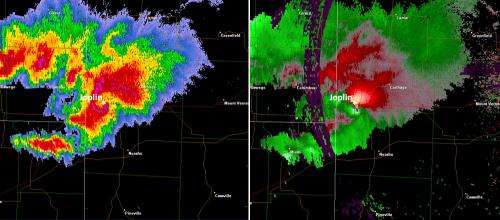NIST tornado reports urge new safety standards

Nationally accepted standards for building design and construction, public shelters and emergency communications can significantly reduce deaths and the steep economic costs of property damage caused by tornadoes. That is the key conclusion of a 2-year technical investigation by the National Institute of Standards and Technology (NIST) into the impacts of the May 22, 2011, tornado that struck Joplin, Mo. Recommendations for achieving these standards are featured in a draft report issued for public comment on Nov. 21, 2013, and are strongly supported by a second NIST report released today that documents impacts observed following the May 20, 2013, tornado in the Newcastle-Moore area of Oklahoma.
The NIST Joplin study was the first to scientifically assess the impact of a tornado in four major categories: tornado characteristics, building performance, human behavior and emergency communication—and the impact of each on life-safety, the ability to protect people from injury or death. It also is the first to recommend that standards and model codes be developed and adopted for designing buildings to better resist tornadoes.
In the majority of buildings studied in Joplin, the research team found that regardless of construction type, the structures did not adequately protect occupants and that Joplin residents had limited access to underground or tornado-resistant shelters. In addition, multiple factors contributed to a delayed or incomplete response by Joplin residents in the tornado's path, including lack of awareness of the tornado's approach, confusion about or distrust of the emergency messages prior to the tornado's arrival, and an inability to perceive risk due to the conflicting information.
The Oklahoma study found that the storm in Newcastle and Moore inflicted an extensive level of damage and destruction to buildings and designated safe areas on par with that seen in Joplin. In both cases, areas designated as safe areas did not adequately protect occupants and essential facilities (such as hospitals) did not remain operational. The dramatically similar findings, the researchers say, demonstrate the need for nationally accepted standards against tornadoes.
The massive tornado in Joplin was rated by the National Oceanic and Atmospheric Administration (NOAA)'s National Weather Service (NWS) as category EF 5, the most powerful on the Enhanced Fujita scale. The multiple-vortex storm destroyed some 8,000 structures in its path and killed 161 people. It was the single deadliest tornado in the United States in the 63 years that official records have been kept.
The Newcastle-Moore, Okla., storm also was rated EF 5. It damaged or destroyed nearly 2,400 structures and killed 24, including seven children who died when the elementary school classroom building in which they took shelter collapsed.
Based on findings from the Joplin investigation, NIST developed 16 recommendations for improving how buildings and shelters are designed, constructed and maintained in tornado-prone regions; and for improving the emergency communications that warn of imminent threat from tornadoes. All of these recommendations are backed by what the team observed in Oklahoma.
The key recommendation proposed in the Joplin report is "the development and adoption of nationally accepted performance-based standards for the tornado-resistant design of buildings and infrastructure to ensure the resiliency of communities to tornado hazards." This includes a call for designing and constructing essential buildings—such as hospitals and emergency operations centers—and infrastructure to remain operational in the event of a tornado.
Following the public comment period on the draft Joplin study, NIST will issue a final report and then work with the appropriate code development organizations to use the study's recommendations to improve model building codes and lay the foundation for nationally accepted standards. NIST also will work with organizations representing state and local governments—including building officials—to encourage them to seriously consider implementing its recommendations.
Comments on the draft Joplin report and recommendations must be received by 5 p.m. Eastern Time on Monday, Jan. 6, 2014. Comments may be submitted via email to disaster@nist.gov or mailed to NIST Technical Investigation Joplin, 100 Bureau Dr., Stop 8611, Gaithersburg, Md. 20899-8611.
More information: NIST NCSTAR 3 (Draft for Public Comment), Technical Investigation of the May 22, 2011, Tornado in Joplin, Missouri, and NIST SP 1164, Preliminary Reconnaissance of the May 20, 2013, Newcastle-Moore Tornado in Oklahoma, are both available at www.nist.gov/el/disasterstudies
Provided by National Institute of Standards and Technology



















